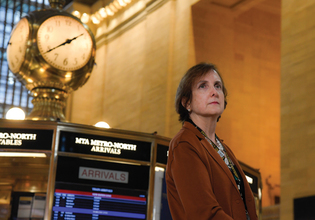
MTA / Marc A. Hermann
She majored in English, she has a law degree—and now she runs a railroad. MTA
president Catherine Rinaldi ’85 spoke with Lenore Skenazy ’81 about bar cars, middle seats, and more.
View full image
Catherine Rinaldi ’85 has kept New York moving. She is president of the MTA Metro-North Railroad and recently stepped down as interim president of the Long Island Rail Road. After graduating from Yale as an English major in 1985, she got her law degree from the University of Virginia. She joined the MTA in 2003 as general counsel and worked her way up. She was chief of staff at MTA headquarters during Superstorm Sandy, head of Metro-North during COVID—and she presided over the opening of the Long Island Rail Road’s $12 billion terminal: Grand Central Madison.
To be sure, there aren’t many women running commuter railroads. But with the combination of both Metro-North and the LIRR, Rinaldi ran America’s
biggest commuter rail system.
Lenore Skenazy: The Metro-North train goes from New Haven to Grand Central Terminal. Did you take it as an undergrad?
Catherine Rinaldi: Actually, Metro-North came into existence in 1983. So for my first couple of years at Yale it was Conrail.
IS: Conrail! Wow! Forgot about that. And do you take Metro-North now?
CR: Yes. I’m a commuter like everyone else.
IS: Does anyone recognize you on the train?
CR: The customers don’t. But my employees know.
IS: Do you have to deal with a lot of complaints?
CR: All the time. But it’s okay, because people are paying for a service, and they want to understand when it’s not delivering for them—or Why can’t you keep the station cleaner? Really lots of different issues.
IS: Do people wish you still had the bar cars?
CR: There is a contingent that would like to see the bar cars come back. We retired those long ago. [With a bar car] you can’t fit as many people on the train. And consuming alcohol provided by the railroad . . .
IS: Ah. Got it. Legal minefield.
CR: I don’t think I fully appreciated how much people love railroads till I came to work for one. It’s suggestive of a simpler time. It’s a very different experience from taking an Uber to the airport. And a lot of people take the same train and the same seat with the same conductors coming through—there’s something comforting about that.
IS: Are conductors the rock stars of the railroad?
CR: Yes. For a lot of customers, the conductor is sort of the face of the railroad.
IS: How do you think being an English major prepared you to run a railroad—or two?
CR: Having a nontraditional background [means] you ask questions without shame or hesitation. And all the writing as an English major has been helpful.
IS: What do you like best about your work?
CR: Leading a team of professionals—track workers, station personnel, third rail men—those jobs people don’t necessarily know [about]. And we keep the region moving. We get people where they need to go.
IS: Which was worse, Superstorm Sandy or COVID?
CR: COVID was much worse. We went from record ridership to, in the space of two weeks, carrying three or four percent. The change in work patterns has had a lasting effect. And in the early days, it was frightening. We had employees out there doing what they had to do to keep the trains running.
IS: I sometimes think New York is so dynamic just because of public transit. We get so much done on our commutes. You too?
CR: I check my emails.
IS: Do you ever take the middle seat?
CR: Funny you should mention that, because it’s kind of the canary in the coal mine as to when our ridership will be back to what we want it to be. We’re seeing more and more people in the middle seat. They don’t like it, but it makes me happy, because that’s what we’re looking for.
 loading
loading